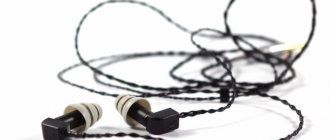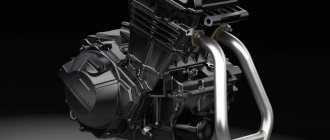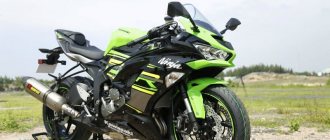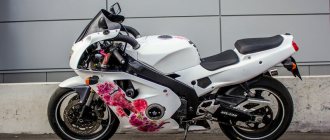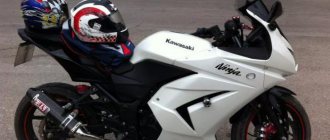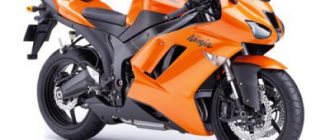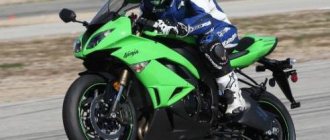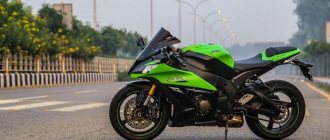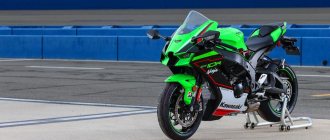THE FORGOTTEN CLASS
One of the latest American magazines asked a funny question: “Will you get a thrill from riding a motorcycle if the engine has less than 1000 cc?” I wonder what ordinary British guys who raced BSA and Velocette would have answered to the snickering Americans half a century ago? After all, they considered the optimal working volume for a single machine to be 500 cm3! Anything more is for carrying a “stroller”...
Alas, now “five hundred” is a forgotten class. European companies have completely rejected them, Americans disdainfully do not notice them, the Chinese and Indians have not yet matured... And only Japanese concerns continue to produce them: moderately dynamic, relatively simple, light and obedient. At Kawasaki we will find a whole range built around a 2-cylinder 4-stroke in-line engine: the sports road GPZ500S, the neoclassic ER-5 Twister, the “urban enduro” KLE500, the cruiser EN500 (a separate article is devoted to this last one in “Moto” No. 9 –2001). Their 400 cc modifications are also produced for the Japanese market.
Dimensions and weight
The length of the bike reaches 2125 millimeters. Its width is 675 millimeters, height – 1165 millimeters. The height of the bike at the saddle is 770 millimeters, and the wheelbase size is 1440 millimeters. The dry weight of the Kawasaki GPZ500 is 171 kilograms, and its gas tank capacity reaches 18 liters. Taking into account fuel consumption of 3.68 per 100 kilometers of road, this motorcycle is very economical.
NO EXTREME
The expression “golden mean” has long been stuck in my teeth. But there’s no getting around it - 2-cylinder Kawasakis are just a good example of a universal motorcycle, capable of both spinning in the city crowd and carrying its riders for hundreds and thousands of kilometers. What to hide? Some specialized machines will cope with any of these purposes better, and much better. But these little ones, relatively speaking, amaze with their diversity of performance properties and tempt with their reasonable price. And the dynamics... Of course, 180 km/h “maximum speed” and 6 seconds “up to a hundred” are not extreme indicators, but, nevertheless, they inspire respect.
The 2-cylinder engine is quite reliable, however... subject to several conditions. First of all, it must be serviced regularly (with oil changes every 6,000 km), and secondly, it must not be “twisted” unnecessarily. Which is quite difficult for a motor that at 3000 rpm only “wakes up” and comes to life at 6000 rpm. Weak points are the camshaft drive, the camshafts themselves and the generator. They warn about their imminent death with the same “good” sound that will certainly “show itself.” At high mileage, the gears of the gearbox begin to “fly out”; units manufactured before 1994 behave especially poorly. The most common defects in the chassis are “sweating” shock absorbers and front forks, wear of the steering column bearings, and rusting of mufflers.
Both the GPZ500S and ER-5 are well-made, versatile machines. Their urban cross-country ability is limited to only a moderate steering angle. The handling parameters deserve a solid “four” - let’s take into account, however, that the motorcycles were designed a decade and a half ago. Don’t be fooled by the “enduristic” appearance of the KLE500: this device is a direct illustration of what a “parquet motorcycle jeep” is. We advise you to refrain from buying GPZs produced before 1994: their 16-inch wheels, to put it mildly, do not contribute to road stability, and you will still have to look for tires for them.
To those who have experienced the delights of a 1000 cc sportbike, the heroes of our story will seem too bland. But if you don’t want to fight with the motorcycle, but to be friends with it, and besides, you are not burdened with either finances or racing experience... then the “mid-range” from Kawasaki is a very good choice.
Review of the Kawasaki GPZ 500 motorcycle (GPZ500S, EX 500, Ninja 500R)
The motorcycle in Europe is equipped with two front brake discs, the S version has a fairing. The motorcycle is great for beginners because it can ride at low speeds and it’s not annoying at all. If desired, the engine spins up to 11,000 rpm and you can gradually start driving. The landing is yes, a little forward and here you need to either just drive quickly so that the wind supports you or turn the clip-ons to the second position. Then the steering wheel will become much higher. In the city the motorcycle behaves perfectly. It is narrow and flows through traffic jams like a charm. The low-torque engine allows beginners to filter literally from the first day without fear of hurting someone. Accelerating to 100 km/h in 4.5 seconds allows you to look at cars like autumn flies: they seem to have wings, but they barely crawl. The first gear spins up to 90 km/h, I didn’t look at the rest, everything happens somehow quickly. Yes, I agree, you can drive around the city in 2-3 gears, but at the beginning you can also engage fourth and fifth. Especially after driving a car. Over time, your consciousness somehow switches and you stop shifting up while keeping high revs. But, I repeat, the motorcycle allows you to drive like a car, slowly purring the engine. Of course, there’s not much to do with this one on the track, it’s not sporty, but on city streets it’s enough even for passengers and luggage.
The motorcycle is great for beginners because it can ride at low speeds and it’s not annoying at all. If desired, the engine spins up to 11,000 rpm and you can gradually start driving. The landing is yes, a little forward and here you need to either just drive quickly so that the wind supports you or turn the clip-ons to the second position. Then the steering wheel will become much higher. In the city the motorcycle behaves perfectly. It is narrow and flows through traffic jams like a charm. The low-torque engine allows beginners to filter literally from the first day without fear of hurting someone. Accelerating to 100 km/h in 4.5 seconds allows you to look at cars like autumn flies: they seem to have wings, but they barely crawl. The first gear spins up to 90 km/h, I didn’t look at the rest, everything happens somehow quickly. Yes, I agree, you can drive around the city in 2-3 gears, but at the beginning you can also engage fourth and fifth. Especially after driving a car. Over time, your consciousness somehow switches and you stop shifting up while keeping high revs. But, I repeat, the motorcycle allows you to drive like a car, slowly purring the engine. Of course, there’s not much to do with this one on the track, it’s not sporty, but on city streets it’s enough even for passengers and luggage.
On the highway, the cruising speed is approximately 120 km/h, this saves fuel and you don’t get tired at all. At a speed of 140 km/h, consumption already increases. In principle, everyone has their own comfortable speed. I have it at just 120 km/h. It’s hard to guess what will happen next, maybe I’ll get used to it and go faster. So far, I personally haven’t accelerated beyond 150 km/h because it was scary. After all, I’m already an adult.
At a speed of 140 km/h, consumption already increases. In principle, everyone has their own comfortable speed. I have it at just 120 km/h. It’s hard to guess what will happen next, maybe I’ll get used to it and go faster. So far, I personally haven’t accelerated beyond 150 km/h because it was scary. After all, I’m already an adult.
I haven’t gone on hikes yet, but I’ll go to the south of Europe from St. Petersburg for May. Well, I'll get there as far as I can. I didn’t experience any problems on trains of 100-200 km. Yes, my height is 180 cm and my weight is 100 kg. It’s comfortable for me to sit on this motorcycle; the footrests are not high, but they don’t catch the road when cornering. The height of the saddle allows you to place your feet on the asphalt and it was very comfortable for short people, for example a girl 168 cm tall. The bike weighs 174 kg, which suggests that it is not a sporty piece of aluminum, but also that anyone can handle it, not “for 200”.
Five hundred cars in general and Kawasaki GPZ500 are not very common in the Russian Federation. Probably, at one time the market was filled with sports four hundred bzzzz bzzzzz bzzzzzzzz. Accordingly, the consciousness of the masses turned out to be turned inside out and now we have here a flurry of the type “where to start? per liter, of course! I think things will gradually level out.
If showing off is not so important to you and you just need a motorcycle for riding around the city and surrounding areas, simple, reliable and convenient - this device is for you.
An old two-pot asshole... This motor has been on Kavas since ancient times, and on different ones, for example, on ER road builders, GPZ sport tours, enduro cle, chopper en. The engine, after being modernized and seriously redesigned, is still alive on ruffs and versus. But just as it rattled the timing mechanism on the rockers on the motos of the 80s, so it rattles on the new ruffs.
By the way - bullshit brakes and design of the first half of the 80s, weak suspension. The engine is strong and traction. But there are few of these live ones, and there is no point in ordering them fresh. Most of them here are from the 80s. The downside to Kave is that it's worthless chrome and the worst workmanship of the Japanese four, which makes these wasters even more dull over time. Among the jambs are problems with the pp and switching unit, carbs and timing mechanism typical for Kavas.
The GPZ500S pleases with the elasticity of the engine... it pulls well from the bottom, it’s light, so its engine is enough... sometimes it even seems too quick)) although my bike is already 20 years old (1994), it holds up vigorously)), in 6 years it will be a rarity )))) I am already given a discount as the owner of a “veteran” when purchasing consumables)))) I recently changed the parts of the starter motor (there is a topic in the NEED HELP section), I thought it would be very difficult to get the parts, but they arrived in a little over 2 weeks (I ordered at Hot Moto on Montazhnaya Street, metro station Ulitsa Podbelskogo), so in principle it’s normal. The bike is not wide, allows you to maneuver in traffic jams, the handling is adequate...
The model was sold under the following names:
Kawasaki GPZ500 / GPZ500S - European versions.
Kawasaki EX500 / EX500R - American versions (before 1993) and versions for other countries (outside Europe and America)
Kawasaki Ninja 500 / Ninja 500R - American versions (1994-2009)
The engine of the Kawasaki GPZ 500 is actually half the engine of the sports version of the Kawasaki GPZ 1000 RX. The maximum declared power is 60 hp, torque is 46 cc. see. This motor, with minor changes, was installed on a large number of other models, in particular - Kawasaki KLE 500, Kawasaki ER-5 and Kawasaki EN500 Vulcan.
2009 was the last year of production of the model, which, despite the release of the ER-6, continued to be produced and sold in the American market. For the market of other countries, the Kawasaki GPZ500 model was produced until 2006 and disappeared from sales immediately after the release of the new model - Kawasaki ER-6.
Chassis and brakes
The bike has a steel frame. It looks dull, but tasteful. Alloy wheels have almost nothing in common with sports wheels in their appearance, but are very aesthetically pleasing. The steering wheel fits well into the exterior and makes driving the motorcycle comfortable even at high speed.
The rear suspension has a travel of 100 millimeters. It is pendulum-type and equipped with a monoshock absorber. The front suspension is a 37mm telescopic fork with 130mm of travel. The rear brakes feature a 230mm disc with a single-piston caliper. The front brakes are a single disc with a diameter of 280 millimeters with a two-piston caliper.
Kawasaki GPZ 40 0 is a sportbike developed in the early 80s of the last century for the Japanese domestic market. Due to its advanced age, this motorcycle can rarely be seen on the road these days, but some copies are still successfully ridden, including across Russian expanses. The GPZ400 first saw the light back in 1983, when its modification GPZ 400F went on sale. However, this first version was more of a classic road bike than a sportbike.
The Kawasaki GPZ 400 F was equipped with an in-line four air-oil cooled engine, but this motorcycle did not last long, only two years, and in 1985 it was replaced by the GPZ 400R, which is most often called simply GPZ, without the letter “R” in the name. Now it was already a full-fledged 400 cc sportbike with the appropriate engine characteristics and a forward-leaning riding position designed to improve aerodynamics. It is this version that is considered to be the “grandfather” of the Kawasaki ZZR 400 and ZXR 400 that subsequently replaced it.
The engine of the updated motorcycle remained the same - an in-line 16-valve four with a volume of 400 cubic meters, but the cooling system was replaced with a liquid one, and the engine itself underwent some modifications. At peak power (12,000 rpm), the Kawasaki GPZ 400 is capable of delivering 59 horsepower and peak torque of 35 nm. The sportbike's engine is quite sharp in acceleration and clearly loves high speeds. For its time, the characteristics of the GPZ 400 could be called quite outstanding - solid power, excellent dynamics, an alloy frame and a 6-speed transmission. By the way, it was his engine that, with some changes, migrated to the Kawasaki Eliminator 400 chopper.
According to reviews from Kawasaki GPZ 400 owners, this motorcycle can be called dynamic. It has good brakes, but is not the easiest to drive. No, of course, this 400 cc model is aimed at beginners, but the engine, which produces almost 60 horsepower, is capable of accelerating it to 180 km/h, exchanging the first hundred in four and a half seconds. You can also feel some instability when cornering - a feature that is also characteristic of the larger representatives of the GPZ line, but you can get used to this feature of the motorcycle. It is also worth paying attention to carburetors - if they are not fully operational, this immediately affects the dynamics and a significant increase in fuel consumption. There are also complaints about the Kawasaki GPZ 400 gas crane, which does not always ensure tightness, and the age of the motorcycle takes its toll. If you forget to turn the fuel tap to the “Off” position, in the event of a fuel tap malfunction, this can result in gasoline leaking out and, optionally, getting into the engine, which, in turn, can lead to water hammer and subsequent engine repair if you try to start the engine.
Hard and not particularly comfortable standard seats are another minus, but it is typical of most sports motorcycles. You will also have to get used to turning on neutral, since sometimes you can’t feel it right away, and sometimes you need to move a little in gear for the gears to engage properly - all Yamaha Viragos have the same feature. But there are no complaints about the reliability of the Kawasaki GPZ 400 transmission, unlike the Kawasaki ZZR series. The standard headlight is surprisingly good, and the presence of a fuel level sensor and an on-board voltmeter is only good news.
For its time, this sportbike, designed for beginner motorcyclists, was quite good. It was produced until 1989, so the youngest copies of the Kawasaki GPZ 400 are already more than a quarter of a century old. However, with proper maintenance, this old sportbike has every chance of surviving to this day and at the same time maintaining good spirits and overall good technical condition.
